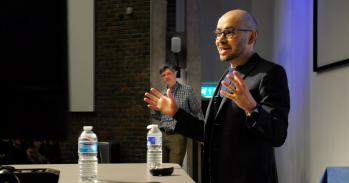
Three alumni of the University of Cambridge were today awarded the 2016 Nobel Prize in Physics for their pioneering work in the field of condensed matter physics.
Three alumni of the University of Cambridge were today awarded the 2016 Nobel Prize in Physics for their pioneering work in the field of condensed matter physics.
The trio become the 93rd, 94th and 95th Nobel Affiliates of Cambridge to be awarded a Nobel Prize.
David Thouless (Trinity Hall, 1952), Duncan Haldane (Christ’s, 1970) and Michael Kosterlitz (Gonville and Caius, 1962) discovered unexpected behaviours of solid materials - and devised a mathematical framework to explain their properties. Their discoveries have led to new materials with an array of unique properties.
The Prize was divided, one half awarded to Thouless, the other half jointly to Haldane and Kosterlitz. The trio become the 93rd, 94th and 95th Nobel Affiliates of Cambridge to be awarded a Nobel Prize.
“This prize is richly deserved,” said Professor Nigel Cooper of Cambridge’s Cavendish Laboratory. “Through the great breakthroughs they’ve made, Thouless, Haldane and Kosterlitz took a visionary approach to understanding how topology plays a role in novel materials.”
Topology is a mathematical concept that accounts for how certain physical properties are related by smooth deformations: a football can be smoothly deformed into a rugby ball (so these have the same topology), but neither of these can be smoothly deformed into a bicycle tube (which therefore has different topology). The Laureates recognized how novel states of matter could arise due to the differing topologies of how the underlying particles arrange themselves at the microscopic level.
The Nobel Assembly made their announcement this morning (October 4), saying: “This year’s Laureates opened the door on an unknown world where matter can assume strange states. They have used advanced mathematical methods to study unusual phases, or states, of matter, such as superconductors, superfluids or thin magnetic films. Thanks to their pioneering work, the hunt is now on for new and exotic phases of matter. Many people are hopeful of future applications in both materials science and electronics.
“The three Laureates’ use of topological concepts in physics was decisive for their discoveries. Topology is a branch of mathematics that describes properties that only change step-wise. Using topology as a tool, they were able to astound the experts. In the early 1970s, Michael Kosterlitz and David Thouless overturned the then current theory that superconductivity or suprafluidity could not occur in thin layers. They demonstrated that superconductivity could occur at low temperatures and also explained the mechanism, phase transition, that makes superconductivity disappear at higher temperatures.
"In the 1980s, Thouless was able to explain a previous experiment with very thin electrically conducting layers in which conductance was precisely measured as integer steps. He showed that these integers were topological in their nature. At around the same time, Duncan Haldane discovered how topological concepts can be used to understand the properties of chains of small magnets found in some materials.
"We now know of many topological phases, not only in thin layers and threads, but also in ordinary three-dimensional materials. Over the last decade, this area has boosted frontline research in condensed matter physics, not least because of the hope that topological materials could be used in new generations of electronics and superconductors, or in future quantum computers. Current research is revealing the secrets of matter in the exotic worlds discovered by this year’s Nobel Laureates.”
Professor Haldane is the current Eugene Higgins Professor of Physics at Princeton University. Born in London in 1951, he came to Christ’s as an undergraduate in 1970 to read Natural Sciences. His PhD was conferred in 1978.
Professor Kosterlitz is the Harrison E. Farnsworth Professor of Physics at Brown University, where he joined the faculty in 1982. He was born to German Jewish emigres in 1942 and his father was the pioneering biochemist Hans Walter Kosterlitz. Professor Kosterlitz, who came to Cambridge in 1965, is the 14th Nobel Laureate affiliated to Gonville and Caius.
Professor Thouless, born in 1934, is Emeritus Professor of Physics at the University of Washington. An undergraduate at Trinity Hall, he was also previously a Visiting Fellow at Clare Hall, where he was awarded a Doctorate of Science in 1985. He has been a Life Member of the college since 1986.
Professor Thouless was also a Fellow of Churchill College from 1961-65, and in 1961 became its first Director of Studies for Physics. He has also held the position of Visiting Fellow at Churchill. He is Churchill's 31st Nobel Affiliate and Trinity Hall's first.
The Master of Caius, Professor Sir Alan Fersht, today warmly congratulated Prof Kosterlitz, who was his exact contemporary at Caius, coming up to Cambridge to read Natural Sciences in 1962. "This is fantastic news," Sir Alan said. "Mike was obviously an exceptionally clever guy. We went to physics lectures together in our first year, and he continued to specialise in Physics in the second year while I specialised in Chemistry. He was a very good physicist, and moved from the UK to America fairly rapidly.
"He was an absolutely mad climber - he disappeared every weekend to go mountain climbing in the Peak District. He lived on Tree Court, and he built a traverse around the room where he would climb using his fingers and hanging on to the picture rail."
More details on previous Cambridge winners can be found here: https://www.cam.ac.uk/research/research-at-cambridge/nobel-prize.
The first Nobel Prize in Physics was awarded in 1901.
This is great, groundbreaking materials science. The work is "beautiful and deep" with big applications in future electronics #NobelPrize
— Dr Paul Coxon (@paulcoxon) October 4, 2016
Check out our story on #NobelPrize -winning Caian Michael Kosterlitz and find out why he used to climb the walls https://www.cai.cam.ac.uk/news/caian-wins-nobel-prize-physics-2016
— Gonville & Caius (@CaiusCollege) October 4, 2016
Congratulations to Christ's alumnus Duncan Haldane! /research/news/cambridge-alumni-win-2016-nobel-prize-in-physics
— Christ's College (@christs_college) October 4, 2016
David Thouless (1952) has been awarded the #NobelPrize in Physics. /research/news/cambridge-alumni-win-2016-nobel-prize-in-physics
— Trinity Hall (@TrinityHallCamb) October 4, 2016
If you wanted to have a quick explanation of topological phases. ☺️ #NobelPrize #Physics #Topology https://twitter.com/nobelprize/status/783245808611135489
— Mete Atature (@MeteAtature) October 4, 2016
It all started at Caius... Co-winner of 2016 #NobelPrize for #Physics Michael Kosterlitz in his Matriculation photo at Caius in 1962 pic.twitter.com/M9p3D15fcl
— Gonville & Caius (@CaiusCollege) October 4, 2016

The text in this work is licensed under a Creative Commons Attribution 4.0 International License. For image use please see separate credits above.




